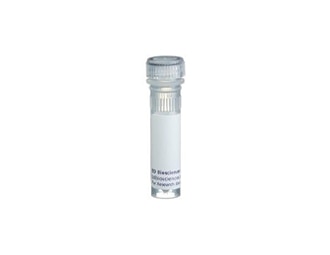Old Browser
This page has been recently translated and is available in French now.
Looks like you're visiting us from {countryName}.
Would you like to stay on the current country site or be switched to your country?




Flow cytometric analysis of human CD178 (FasL) expression on CD178-transfected cells. The mouse T cell lymphoma cell line, L5187Y was untransfected (right panel) or transfected with human CD178 cDNA (left panel), then treated with a metalloproteinase inhibitor, KB8301. KB8301 blocks CD178 cleavage, resulting in high levels of cell surface CD178. Both transfected and untransfected cells were stained with either Biotin Mouse IgG1 κ Isotype Control (Cat. No. 555747; dashed line histogram) or Biotin Mouse Anti-Human CD178 (Cat. No. 556373/556374; solid line histogram) followed by Streptavidin-PE (Cat. No. 554061). Fluorescent histograms were derived from gated events with the side and forward light-scattering characteristics of viable cells.


BD Pharmingen™ Biotin Mouse Anti-Human CD178

Regulatory Status Legend
Any use of products other than the permitted use without the express written authorization of Becton, Dickinson and Company is strictly prohibited.
Preparation And Storage
Recommended Assay Procedures
Biotin-conjugated NOK-1 (Cat. No. 556376) is recommended for flow cytometry (titrate between 0.06 to 1 µg/1x10^6 cells). Biotin-conjugated NOK-1 is also available in a 100 test size (Cat. No. 556374), and has been optimally titrated for use in flow cytometry. NOK-1 has also been used for immunoprecipitation (see purified format, Cat. No. 556372), and to neutralize the cytotoxic activity of FasL. The NA/LE™ format of NOK-1 (Cat. No. 556371) should be used for all functional assays. NOK-1 and a related human FasL clone, NOK-2 (purified, Cat. No. 556376; BD NA/LE™, Cat. No. 556375) may give different profiles in neutralization assays. It is thought that NOK-1 and NOK-2 recognize different FasL epitopes. Neither NOK-1 and NOK-2 are suggested for western blot analysis. Clone G247-4 (Cat. No. 556387) is suggested for western blot.
Product Notices
- Since applications vary, each investigator should titrate the reagent to obtain optimal results.
- An isotype control should be used at the same concentration as the antibody of interest.
- Caution: Sodium azide yields highly toxic hydrazoic acid under acidic conditions. Dilute azide compounds in running water before discarding to avoid accumulation of potentially explosive deposits in plumbing.
- For fluorochrome spectra and suitable instrument settings, please refer to our Multicolor Flow Cytometry web page at www.bdbiosciences.com/colors.
- Please refer to www.bdbiosciences.com/us/s/resources for technical protocols.
The NOK-1 monoclonal antibody specifically recognizes CD178. Fas (CD95; APO-1) is a 45 kDa cell surface protein that mediates apoptosis when cross-linked with agonistic anti-Fas antibodies or by Fas ligand (FasL; CD178). Fas belongs to the TNF (Tumor Necrosis Factor)/NGF (Nerve Growth Factor) receptor family, and is expressed in various tissues and cells including the thymus, liver, ovary and lung. CD178 (FasL), a member of the TNF cytokine family, induces apoptosis by binding to Fas, its cell-surface receptor. FasL may exist as either membrane bound or soluble forms and is expressed by activated T and NK cells. FasL may also be constitutively expressed in some immunologically privileged sites, e.g., eye and testis. Fas and FasL play an important role in the induction of apoptosis, and thus regulate a variety of immunological responses.
The NOK-1 antibody clone has been reported to recognize human FasL, recognizing both the membrane bound (FasL) and soluble (sFasL) forms. It is reported that the epitope for NOK-1 has been mapped to the COOH-terminus of FasL, at the region implicated in Fas binding. FasL and sFasL have been reported to migrate at reduced molecular weights of 40 and 26 kDa, respectively. However, the molecular weights observed in a particular sample may vary according to FasL and sFasL glycosylation and breakdown patterns as described in the literature. The NOK-1 antibody clone is not recommended for the Western blot application.
Development References (6)
-
Griffith TS, Ferguson TA. The role of FasL-induced apoptosis in immune privilege. Immunol Today. 1997; 18(5):240-244. (Biology). View Reference
-
Kayagaki N, Kawasaki A, Ebata T, et al. Metalloproteinase-mediated release of human Fas ligand. J Exp Med. 1995; 182(6):1777-1783. (Clone-specific: Flow cytometry, Neutralization). View Reference
-
Lynch DH, Ramsdell F, Alderson MR. Fas and FasL in the homeostatic regulation of immune responses. Immunol Today. 1995; 16(12):569-574. (Biology). View Reference
-
Orlinick JR, Elkon KB, Chao MV. Separate domains of the human fas ligand dictate self-association and receptor binding. J Biol Chem. 1997; 272(51):32221-32229. (Clone-specific: Immunoprecipitation, Neutralization). View Reference
-
Takahashi T, Tanaka M, Brannan CI, et al. Generalized lymphoproliferative disease in mice, caused by a point mutation in the Fas ligand. Cell. 1994; 76(6):969-976. (Biology). View Reference
-
Tanaka M, Suda T, Takahashi T, Nagata S. Expression of the functional soluble form of human Fas ligand in activated lymphocytes. EMBO J. 1995; 14(6):1129-1135. (Biology). View Reference
Please refer to Support Documents for Quality Certificates
Global - Refer to manufacturer's instructions for use and related User Manuals and Technical data sheets before using this products as described
Comparisons, where applicable, are made against older BD Technology, manual methods or are general performance claims. Comparisons are not made against non-BD technologies, unless otherwise noted.
For Research Use Only. Not for use in diagnostic or therapeutic procedures.
Report a Site Issue
This form is intended to help us improve our website experience. For other support, please visit our Contact Us page.